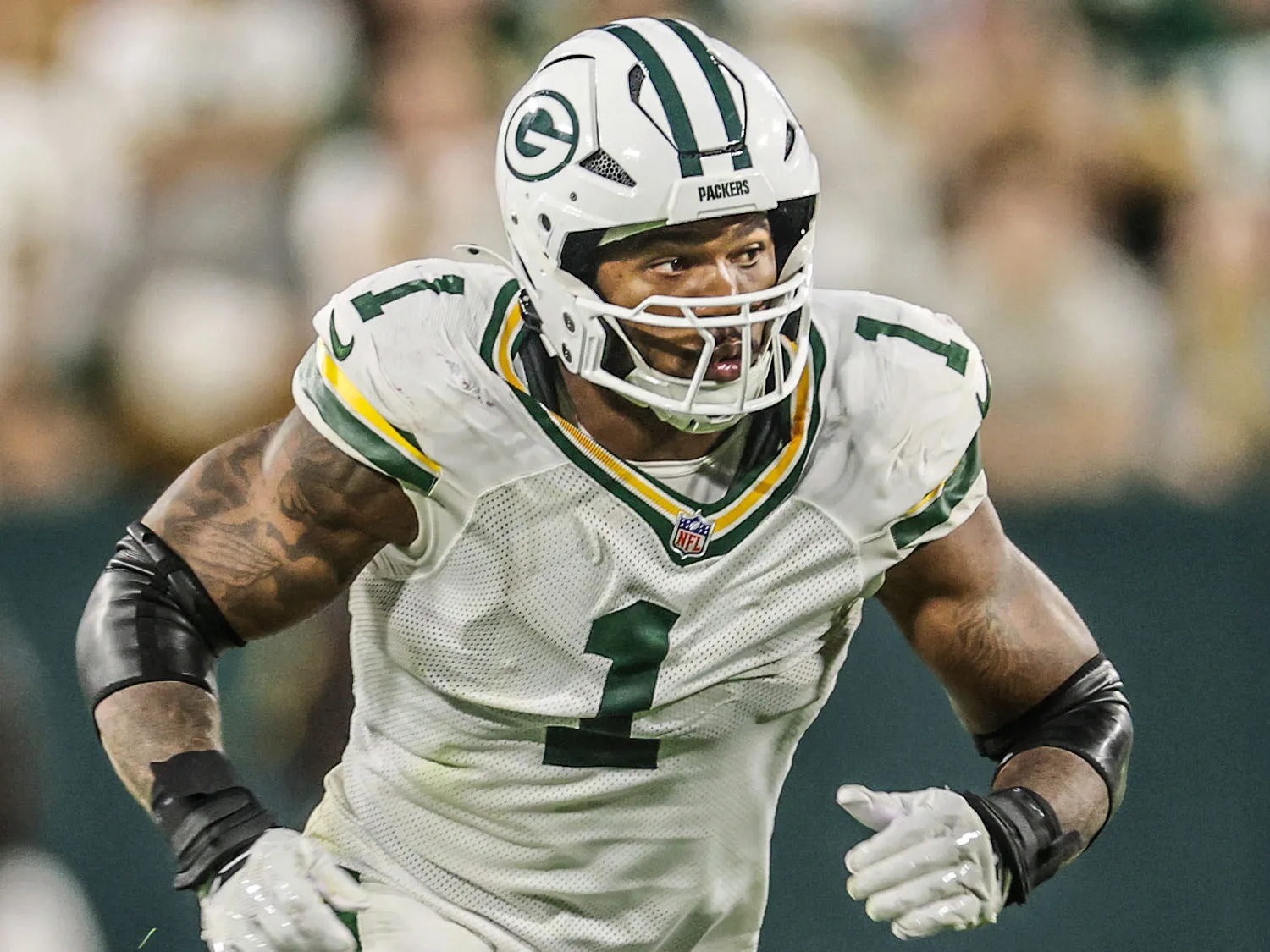
Quick Slant: SNF - The Bridge That Led Back Was Reduced to Ashes
Mat Irby’s Quick Slant
One February night, peacefulness settled over Dallas. The air was 45 degrees, clear and tranquil, ideal for a small sect of socialites wandering beneath the neon of Victory Plaza, as still as a suburb. The news cycle was light: the Dallas Open was underway in Frisco, a Led Zeppelin tribute band filled the House of Blues, and locals braced for their nightmare Super Bowl—Chiefs versus Eagles—just days away. For now, among the modest crowd, there was only conversation, laughter, the clink of glasses and silverware against ceramic—only calm distraction.
Clocks flipped to 11:12 p.m., and the hush began to crack. Phones lit up, and a warm, lively, communal buzz succumbed to a restless, tense murmur. Soon, numb shock settled on the stomachs of every person there: Luka Dončić, the basketball star who had led Dallas to within three games of a championship only months before, had been traded to the Lakers.
It landed like a duel in Verona. Nothing could ever be the same; the city’s future could never again resemble its past. Conversations stammered, laughter froze. The Rubicon was not merely crossed; the bridge that led back was reduced to ashes.
The damage this did to a fanbase cannot be understated. Supporters burned jerseys, traded season tickets, made protest signs on posterboard, and a few bought tickets just to chant their frustrations at the general manager: “Fi-re Ni-co!” From that moment, the city existed in a new reality, defined by absence, anger, and an Alamoic spirit of revolution.
By summer’s end, a miracle closed the open wounds, courtesy of one of the most improbable acts of serendipity the basketball gods have ever gifted anyone; from the rubble, a sudden spring of hope erupted. The Mavs won the lottery, gained one of the prospects of a generation, and whistled as they walked down the sidewalk, hands in pockets in performative control, as if it had been planned all along. The fanbase had been tortured; in the end, there was consolation. Calm, once more, settled on the city.
Flash forward to August 28. The heat index was over 100°. “What’s new?” grumbled the collective inner monologue of a city, “It always is this time of year.” People in cubicles pined for the chance to break free, dreading a thunderstorm that would soon clog 635 with the obstacles of rush hour. The Weeknd was slated for a show at the American Airlines Center. The lights of the Omni welcomed the HBCU Classic, hosted by the Texas Legends. Kids arrived home from school—one week practically in the books. Otherwise, it was business as usual.
Then, the clock struck 4:11 p.m., and Jerry Jones stammered with labored breaths before his monotone bullhorn barked a tone deaf message at the healing Metroplex: “Hold my beer.”
DL Micah Parsons was possibly the fanbase’s favorite Cowboy; today, almost inexplicably, he is a Packer. The fans didn’t want it. Parsons, a lifelong Cowboys fan, didn’t either. The implications were immediate: “The defense is in shambles. The season is over.”
I won’t debate whether the move is correct; only one QB since 1995 has won the Super Bowl while earning over 13% of his team’s cap—Mahomes, who did it twice. By 2028, Parsons, a non-QB, is projected to earn 12.9%. Certainly, the analytics don’t support such a salary for an edge rusher. But for a fanbase that had only recently scraped its heart off the floor, this slapped it back to the cold earth and stamped it with the heel of a boot.
Now Parsons returns to Dallas in green and gold and under a spotlight—the pageantry, the tensioned brass fanfare, the Carrie Underwood of it all—so the world may note how underwhelming the Cowboys now are, and how desperately they could use just one soul who could get to the passer. If only such a player were available.
Packers
Implied Team Total: 26.5
The Packers are coming off a surprising loss to Cleveland, which many had pegged as one of the worst teams in the league (I think they are better than people think they are, led by a quality defense, but I digress). Thus far, the Packers remain one of the best teams in the NFL, according to Pythagorean expected wins, although the season is young.
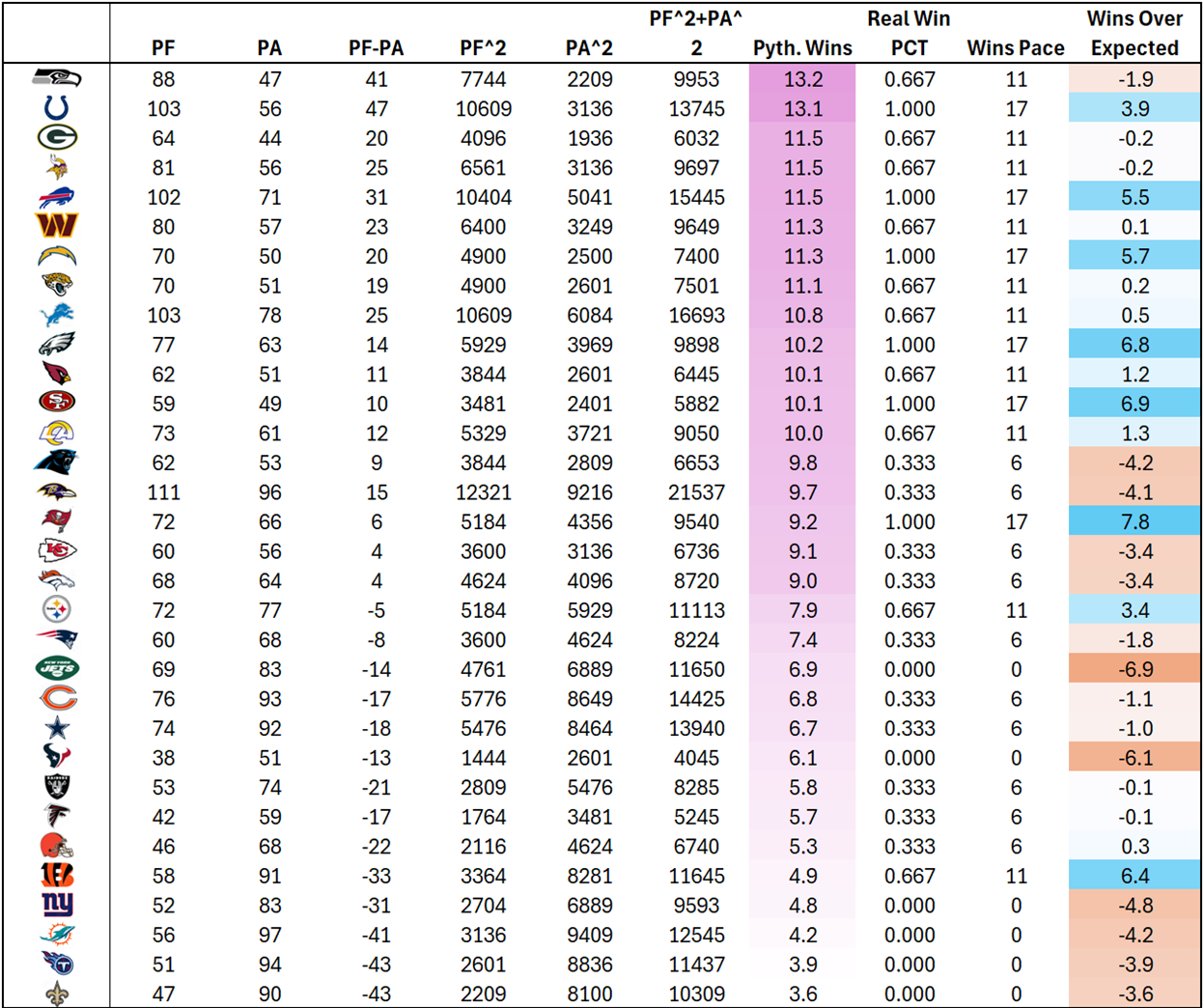
At its face, the game seems like an apparent mismatch, reinforced by the 6.5-point spread, where Green Bay is a road favorite. The Packers have been excellent both offensively and defensively, while the Cowboys have only been good on one side of the ball.
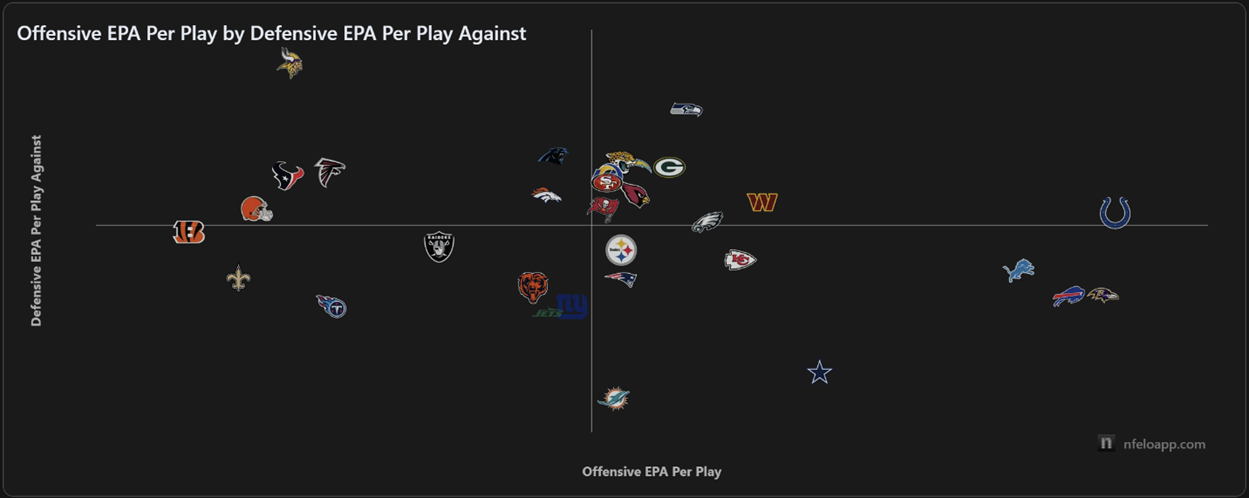
The Packers have a below-average total play volume this season, much of it dragged by their 48 offensive snaps in a Week 1 slog against Detroit, a game they won, but in which they were heavily outpossessed. From a neutral game script, the Packers rank sixth in seconds per snap (30.7). This is not unusual. Since HC Matt LaFleur took over in 2019, the Packers are tied for the second-slowest time to the line (30.1 neutral seconds-to-snap).
The Packers are also naturally run-focused in their current form. While they had a positive pass rate over expected (PROE) value in each of LaFleur’s first three seasons (with Aaron Rodgers at QB), the Packers have experienced neutral or negative PROE values ever since. Only the Colts and Eagles had a lower PROE in 2024. This season, the Packers are again returning a negative PROE through three games.
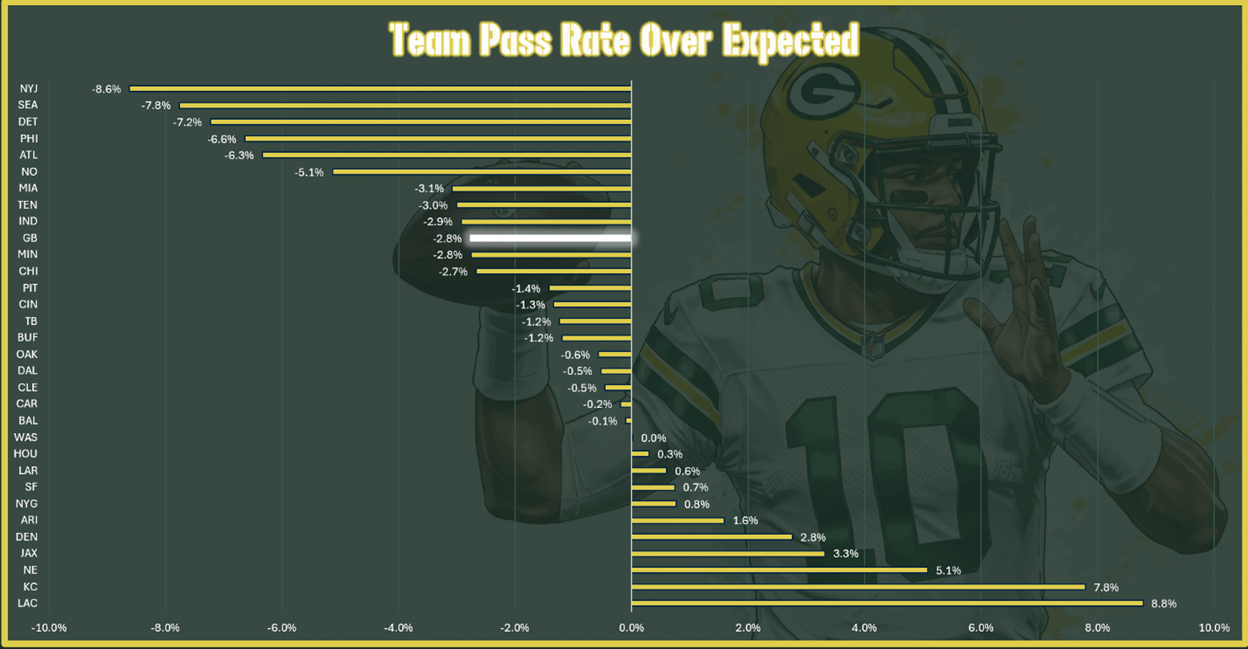
The Packers are efficient, however, as McShanahan systems are wont to be. They rank eighth in offensive EPA.
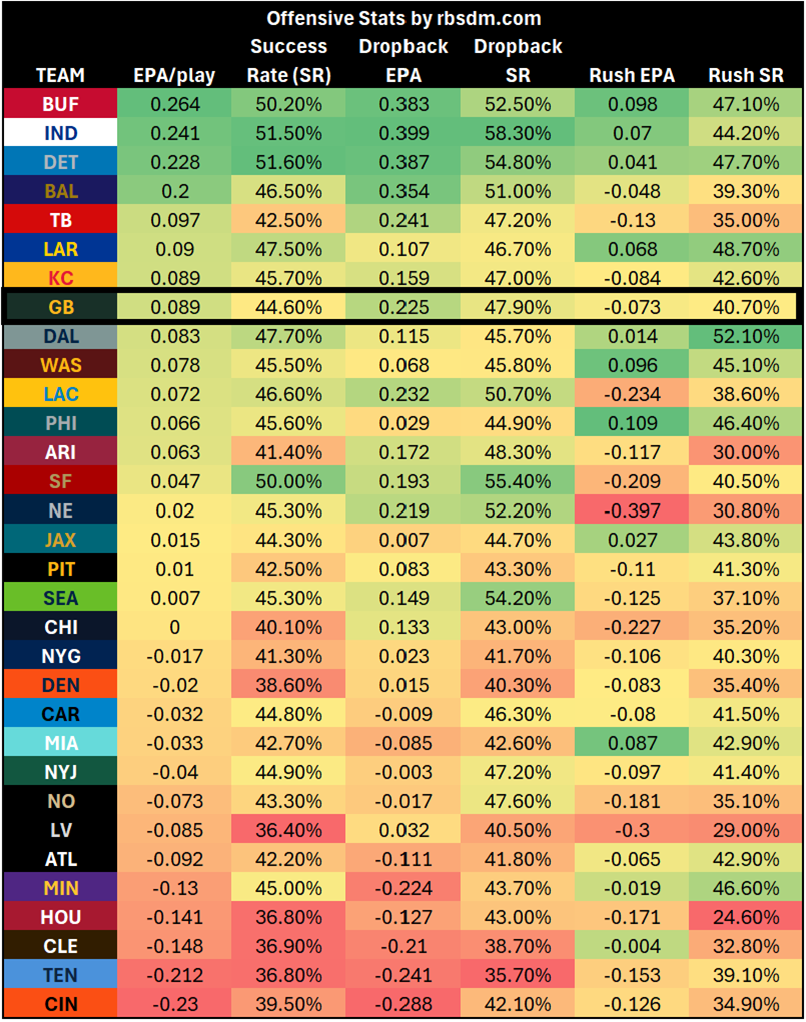
QB Jordan Love, once a popular punching bag in Wisconsin for not being Tee Higgins or Brandon Aiyuk (Packers fans were livid when the team selected a project QB instead of a weapon for then-QB Aaron Rodgers), now leads the team. Since taking the reins three years ago, Love has yet to rise to the forefront of public consciousness. Still, his teams have consistently won games, he has shown above-average physical tools, and he carries a ruthless streak that only seems to grow under brighter lights. For all we’ve seen, Love somehow remains an enigma, and for most, the jury is still out on whether he has fully acquitted himself of not being a WR.
So far in 2025, the returns are solid, although, to a degree, in that same puzzling manner. Love has just 42.6 expected points (EP, 33rd), according to RotoViz, but +12.0 fantasy points over expected (FPOE, 7th). Among all QBs with no minimums, this ranks as the 11th most significant disparity in favor of efficiency; it is fourth among QBs with at least 20 dropbacks.
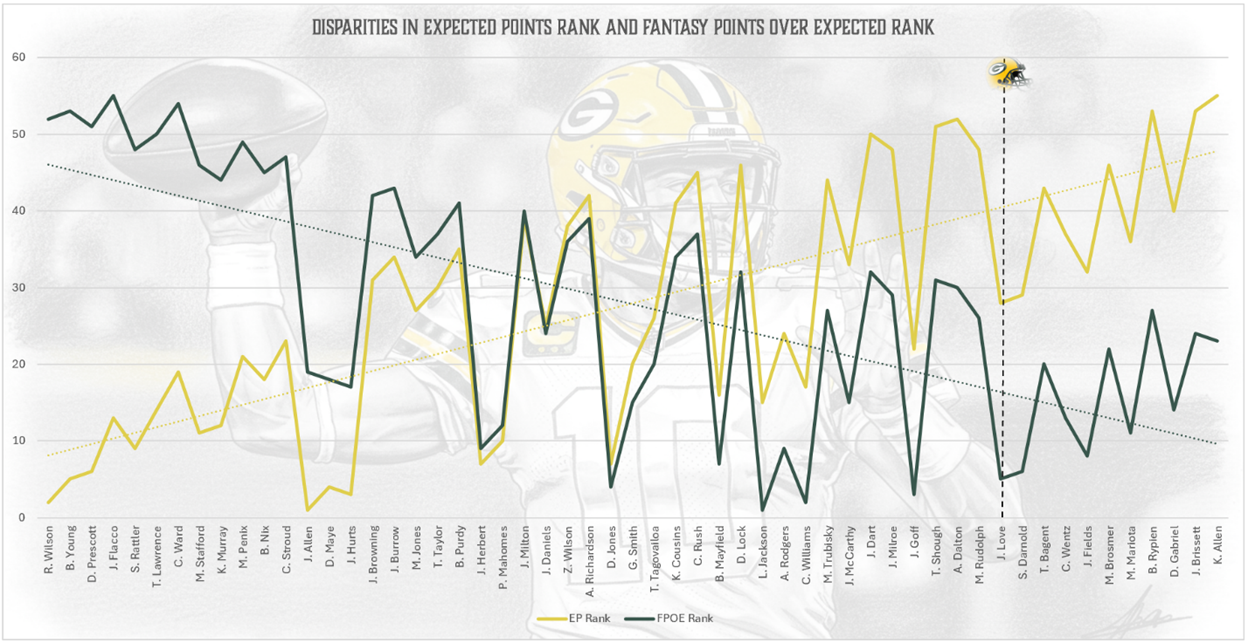
Part of the lack of efficiency is tied to simple volume. Love only has 88 dropbacks (28th). No QB has more fantasy points (54.55) on fewer dropbacks. Yet, as it is, Love ranks only 12th in PPR. His rate metrics are impeccable, with the fourth-best EPA + CPOE composite rate in the league.
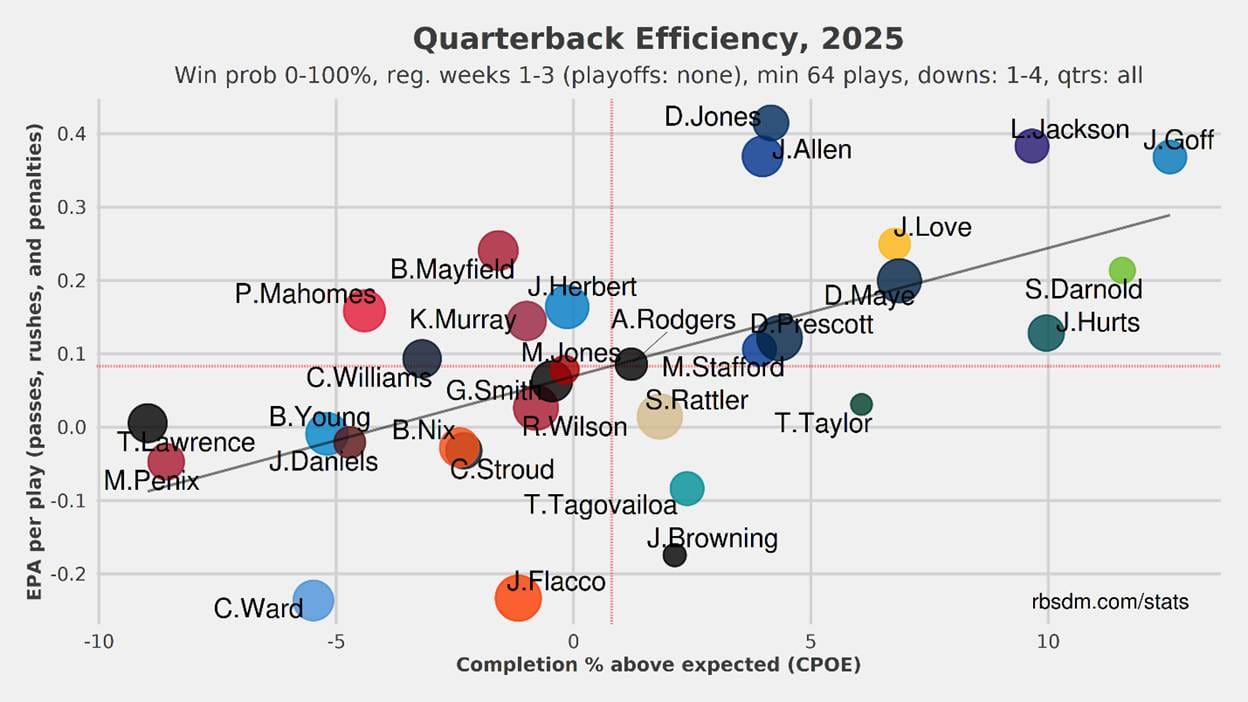
On its face, Love should have an incredible matchup against Dallas. Dallas’ defense, without Parsons, has been transformed from functional meat and potatoes to cold gruel. Dallas only surpasses Miami in EPA per play allowed, and also ranks 31st in EPA per dropback allowed, meaning they have one of the most exploitable matchups through the air.
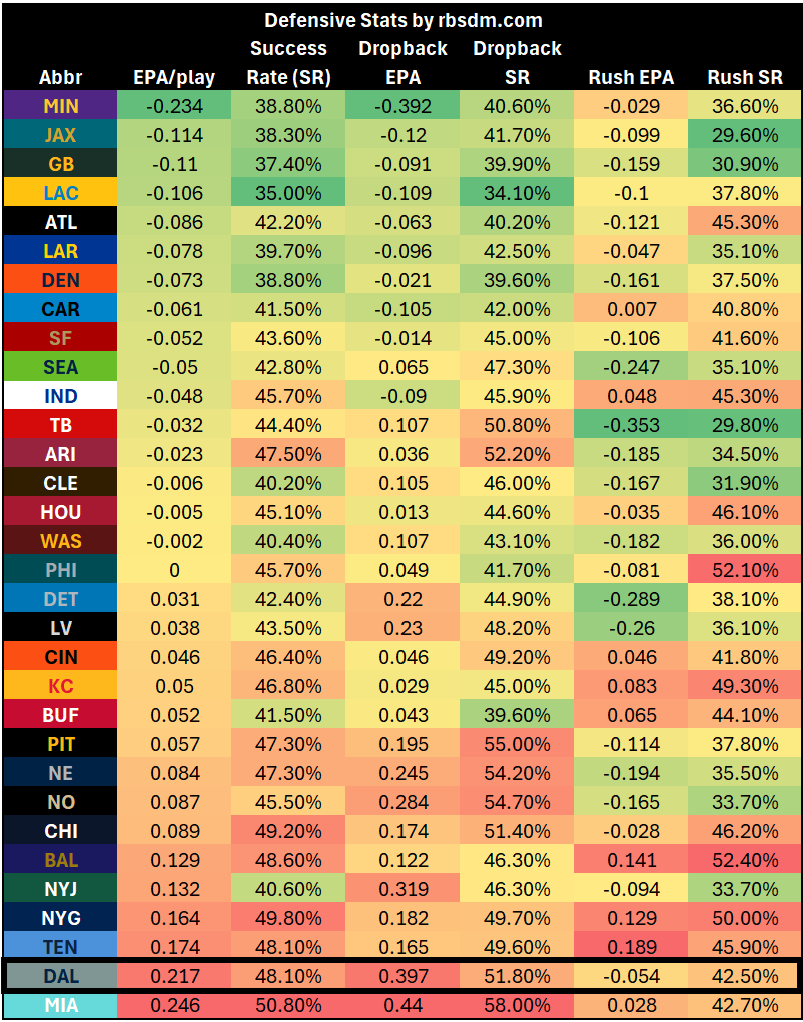
This has been heavily reinforced through two consecutive blowouts as a pass defense, neither of which was at the hands of a particularly well-regarded offense (NYG, CHI). Over the past two weeks, the Cowboys have allowed the most passing yards, adjusted net yards per attempt, TDs, air yards, and deep throw percentage, while ranking in the bottom five in completion percentage over expected (CPOE), first downs surrendered, QB rating, and pressure rate over expected (PrROE).
This suggests that when facing the Cowboys, all opposing passing game contributors should be prioritized for fantasy purposes. The problem from a macro view is that the Packers themselves are heavily favored, and they tend to respond conservatively in games in which they are leading.
Since Jordan Love became the Packers’ starting QB in 2023, the team has the second-highest run rate (55%) in games when they are favored by at least six points, as they will be Sunday. Their 29.8 seconds to snap in such games is tied for the slowest at the line. During the same period, the Packers have averaged 28.9 seconds to snap (4th) on offensive plays when they hold a lead of seven or more, and their run rate is 56% (5th).
As such, there is still reason to be pensive about Love, despite what appears to be a mismatch in terms of skill. For those who'll play him, the hope is that the game is closer than expected or, perhaps more likely, Love scores enough early in the game to make up for it if the Packers ease up later.
The Packers have a +10.69% PrROE allowed (27th), which is somewhat surprising for such a functional team. Context is important, and the Packers have already faced off against Detroit, Washington, and Cleveland—a stringent set of pass rushers—and are missing arguably their best offensive lineman, RT Zach Tom, due to an injury suffered in Week 1.
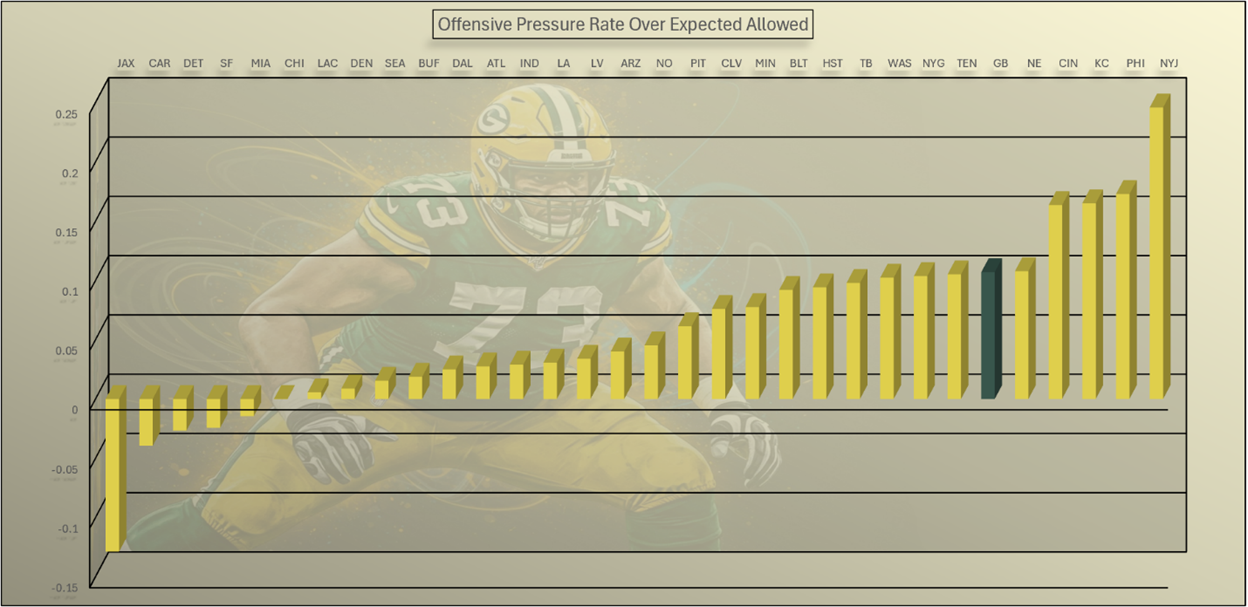
The Cowboys' PRoE is +4.37% (16th), so they are average in this regard, but they still show a relative advantage in getting to the QB in this game.
A significant issue for Love this season has been his inability to handle pressure. Love has an 88.1-point QB rating drop when pressured vs. from a clean pocket. This is the most significant disparity in the league.
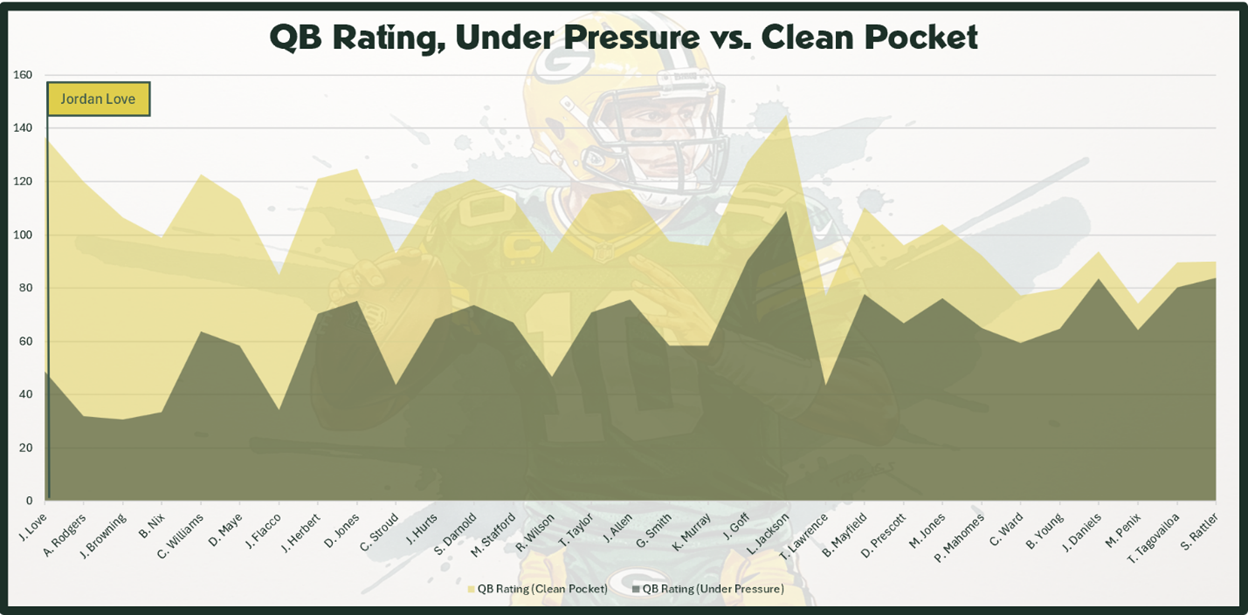
Love also has a relatively neutral matchup against the types and rates of coverage the Cowboys run, ranking 13th in Fantasy Points’ coverage matchup expected points/dropback (EXP FP/DB) model, with 0.50 EXP FP/DB.
The Cowboys get torched whenever they run man, surrendering a whopping 2.43 FP/DB, and so they only use it sparingly. They are second in the NFL in zone defense rate (88.8%), where they surrender 0.61 FP/DB—still last in the league. The Cowboys use a 2-high concept on 54.2% of their plays (10th).
Even in 2-high looks, the Cowboys are susceptible to being beaten deep, surrendering 10 deep throws (3rd), 428 yards (1st), and three TDs (1st) from a Cover-2 alignment.
The Packers have a famously broad target dispersion; added to their lower play volume and run-heavy approach, this makes predicting which pass-catchers to utilize tricky to pin down. The Packers have three players with at least a 15% target share, with TE Tucker Kraft leading the way (20%).
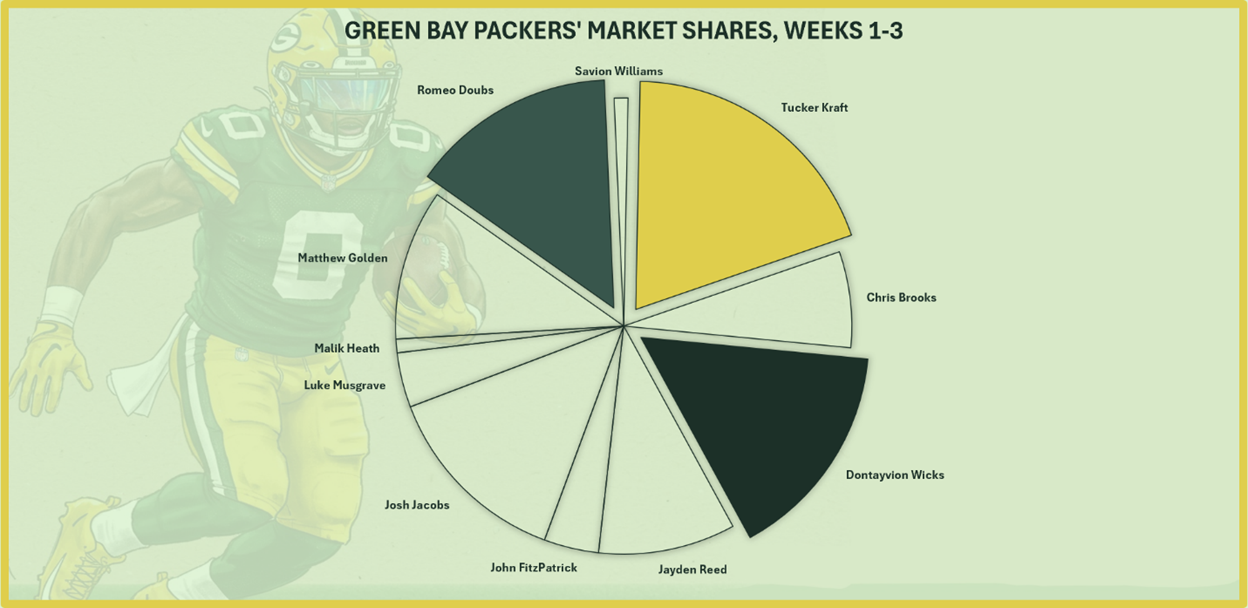
Below that threshold is WR Matthew Golden (11%), whom the Packers selected with the 23rd overall pick of the NFL draft—their first first-round WR since Javon Walker in 2002. Golden was a popular sleeper this summer, but people are already starting to tire.
I would recommend that you stand firm on holding Golden; playing him is another matter. Until he earns a meaningful target share, it’s guessing when the wind will blow. Fantasy GMs may be tempted to play him this week, sensing a killer matchup and expecting the Cowboys to be vulnerable to his deep speed, but I’d be fine watching him go off on my bench. What matters now is seeing signs he can become a real contributor later this year.
Kraft is the only Packers’ pass-catcher who is overly successful against the type and rates of coverage that the Cowboys utilize; he is expected to score 0.49 FP/route run (21st among WRs and TEs), according to Fantasy Points’ Coverage Matchup model. Against 2-high zone looks, Kraft scored 0.41 FP/RR last year (T-17th among TEs).
And that is with emphasis strictly on the types and rates of coverage alignments the Cowboys utilize. The actual matchup is considered fair by the PFF Matchup tool. LB coverage is a strength of the Cowboys.
The WRs have a much better matchup on paper; WRs Dontayvion Wicks and Romeo Doubs each have a good matchup according to the PFF Matchup tool, while Golden’s matchup grades out as fair. Due to the zone coverage and how the Packers move their weapons around, no pass-catcher is expected to face off against any one defender for more than 12 routes on Sunday. WR Jayden Reed is on IR.
RB Josh Jacobs is off to a sluggish start, but circumstances may be aligning for him in this one.
All the stuff I wrote about Love and how the Packers may deprioritize Love if they jump out to a lead? The inverse is true for Jacobs. If we expect a lead, we should expect Jacobs to have a substantial amount of usage.
In 2024, Jacobs had the second most carries in games where his team led by seven points or more (119), trailing only Derrick Henry. This included eight carries from inside the five-yard line (T-1st) and a weighted opportunity of 92.8 (4th). The Packers remain committed to getting the ball to Jacobs, even when his efficiency craters, in these situations.
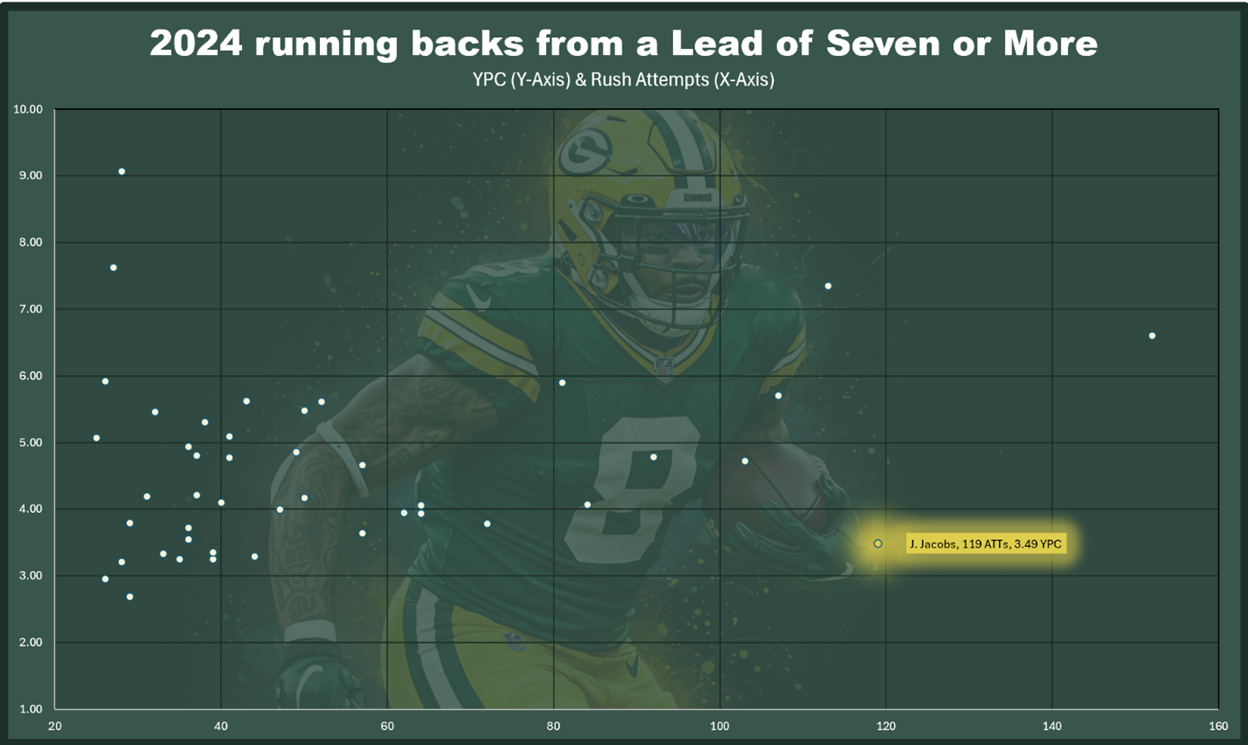
So far, Jacobs has been a disappointment, with 40.8 fantasy points (19th), just 13.6 per game. He is coming in under expectation, according to Fantasy Points data, where he has 17.6 XFP/G. He has been inefficient, holding a -0.93 rush yards over expected/attempt (RYOE/ATT), according to NextGen Stats. He has faced stacked boxes on 27.59% of his attempts (13th).
It is again important to remember the defenses the Packers have faced. Detroit (1st) and Washington (7th) each rank in the top seven in fewest YBC/ATT allowed. In PFF rush defense grade, the Lions rank seventh, the Commanders second, and the Browns first. Jacobs has 1.16 yards before contact per attempt (YBC/ATT, 64th),
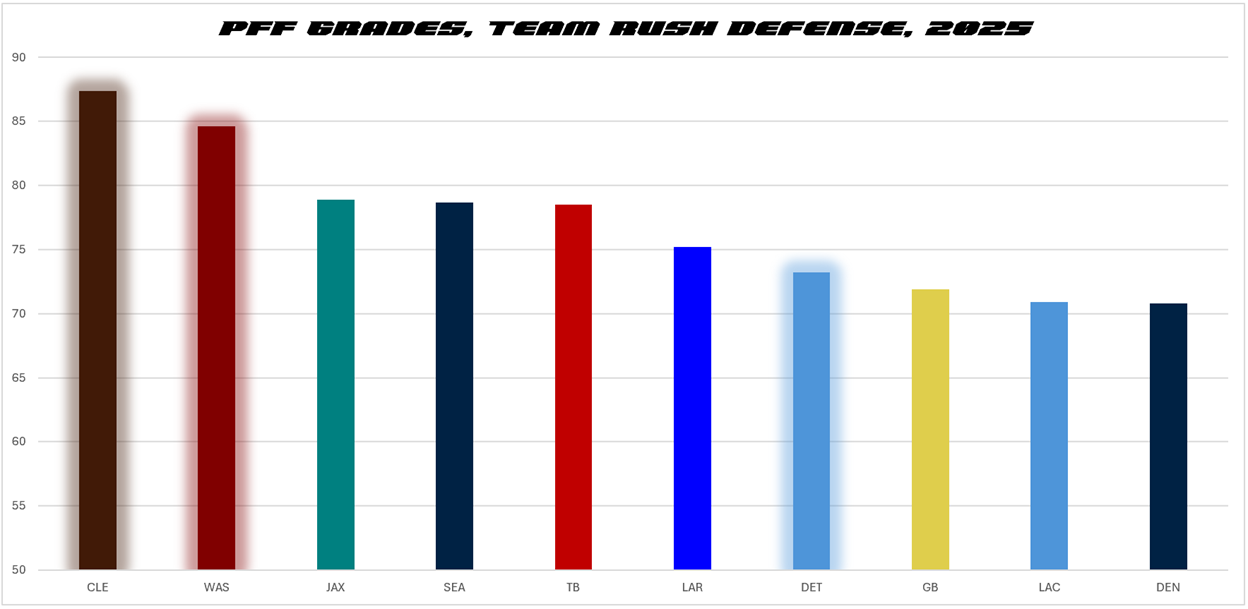
This may come as a surprise, as the Cowboys appear to have improved in rush defense since last year based on raw statistics. They’ve mostly kept the Eagles, Giants, and Bears to lower rush totals in the first three games after surrendering 0.84 EPA per rush a year ago (31st). It could be a mirage, however. PFF has the Cowboys ranked 31st in team rush defense.
A look under the hood suggests a Cowboys’ pass funnel, as they have the fourth-largest gap between rush EPA and dropback. It’s a bit of an apples-to-oranges comparison moving from efficiency to raw stats, but it's worth noting that Dallas has been tested less frequently as a rush defense in 2025, so the yardage numbers alone might not tell the whole story.

Jacobs is also an all-purpose back, insulated by pass-catching acumen; he has a 14% target share (T-9th). Dating back to last year, the Cowboys have been vulnerable to pass-catching RBs. Look for Jacobs to get back on track in this one.
